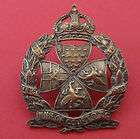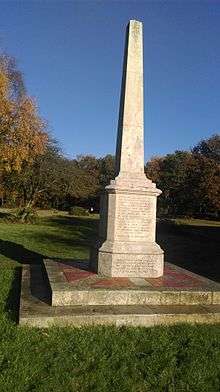Inns of Court Regiment
| Inns of Court Regiment | |
|---|---|
 Inns of Court OTC cap badge | |
| Active | May 1932 - May 1961 |
| Country |
|
| Branch |
|
| Type | Infantry / Cavalry |
The Inns of Court Regiment (ICR) was a British Army regiment which existed under that name between May 1932 and May 1961. However, the unit traces its lineage back much further, to at least 1584, and its name lives on within 68 (Inns of Court & City and Yeomanry) Signal Squadron part of 71 (City of London) Yeomanry Signal Regiment.
History

In the 14th to 16th centuries, judges were called upon to perform functions which in modern times would be hardly considered to come within the judicial office, and accordingly, members of the Inns found themselves fighting in the wars of King John or against Robert the Bruce. One such defence was organised in 1381 against Wat Tyler, during the Peasants' Revolt (when the Chief Justice was killed). In 1467, the Chief Justice of the Exchequer, then Recorder of the city of London, was instrumental in defeating a Lancastrian attack on the city of London. Further accounts, such as Henry Machyn's diary (1554), tell of more localised defences when "On the xij day of Juin was a gret fray be-twyn the Lord Warden's servants of Kent and the Ines of Greys Inn and Lynkolne(s) Inn, and some sleyn and hurt."[1]
The first organised body formed by the Inns of Court appears to have been in Holborn, London, in 1584. At that time, associations known as trained bands were formed to assist in the defence of the country from the Spanish Armada. The deed itself, associating the members of Lincoln's Inn, is still in existence, having been preserved by its first signatory, Thomas Egerton, then Solicitor-General, and afterwards Lord Chancellor.
The history is ambiguous thereafter, although many lawyers were known to join the Royalists, and their clerks the Parliamentarians, during the English Civil War. Certainly members of The Inns were called out against the Jacobite rising of 1745 and the Gordon riots of 1780. Indeed, future prime minister William Pitt the Younger served in the Lincoln's Inn Company.
The Bloomsbury and Inns of Court Volunteers were reformed in 1797 during the Napoleonic Wars. It was shortly afterwards that the regiment gained its enduring nickname. During a review by King George III in Hyde Park in 1803, the King used his dislike for lawyers – particularly ones carrying arms – to name the massed ranks of the Law Association as "The Devil's Own".[2] "It is understood that the King was in high health and excellent spirits at the time. When the 'Temple companies' had defiled before him, his Majesty enquired of Lord David Erskine, who commanded them, as lieutenant colonel, what was the composition of that corps? 'They are all lawyers, Sire,' said Erskine. 'What! What! 'exclaimed the King, 'all lawyers? all lawyers? Call them the Devil's Own, call them the Devil's Own!" "And the Devil's Own they were called accordingly."[3] Even at the present day this appellation has not wholly died away.
The modern history of the regiment began again in 1859, shortly after Crimea, with the formation of the 23rd Middlesex (Inns of Court) Rifle Volunteer Corps. In 1881, the unit became a battalion of the Rifle Brigade and was renamed the 14th Middlesex (Inns of Court) Rifle Volunteer Corps in 1889. The regiment then formed part of the 2nd London Volunteer Brigade and the "Grey Brigade". In 1888 a mounted infantry detachment was formed and subsequently became known as "B" (M.I.) Company, and a contingent of 30 mounted infantry, 19 cyclists and 1 signaller joined the City Imperial Volunteers for service in South Africa during the Boer War.
In 1908 the Territorial Force was formed and the regiment became the 27th (County of London) Battalion, The London Regiment (Inns of Court); but almost immediately it was changed into an officer training unit under the designation the Inns of Court Officers' Training Corps (I.C.O.T.C.) with responsibility for training literally thousands of British officers prior to their deployment on the front line. The regiment had an establishment of one squadron of cavalry (I.C.O.T.C. Squadron, formerly "B" (M.I.) Company) and three companies of infantry. In 1914, the Inns of Court Reserve Corps was formed, consisting of former members of the Inns of Court Rifle Volunteers; and in 1917 the 1st Cadet Battalion, Inns of Court, was formed to train boys under military age.

In 1920 the regiment was reformed with an establishment of one squadron of cavalry and two companies of infantry. Its designation was changed to the Inns of Court Regiment (ICR) in 1932 when it was again reorganised along similar lines. The two infantry companies were converted to light tank cavalry squadrons in 1937 and two years later formed the Royal Armoured Corps Wing, Sandhurst. In 1939 the mounted squadron joined a cavalry training regiment in Edinburgh, but this was disbanded in 1940. From 23 January 1941, until 15 January 1943, the regiment was part of the 9th Armoured Division in Great Britain.[4] From 1943, it was under the direct command of 1 Corps, the assault formation of 21 Army Group and later led the advance of 11th Armoured Division.
On D-Day, "C" Squadron of the regiment landed on Juno Beach with the 3rd Canadian Infantry Division.[5] During the campaign in Northwest Europe of 1944-45, the Inns of Court, organised as an armoured car regiment, was the reconnaissance asset of the I Corps.[6]
On 1 April 1947, the regiment was again reformed, as the Armoured Car Regiment of the 56th (London) Armoured Division, T.A., later to become the Reconnaissance Regiment of the 54th East Anglian Division. In 1956, the Northamptonshire Yeomanry was reduced to one squadron and amalgamated with the Inns of Court Regiment as "The Northamptonshire Yeomanry "D" Squadron, The Inns of Court Regiment". This was reversed when, in 1961, The Inns of Court Regiment amalgamated with the City of London Yeomanry (Rough Riders) to form The Inns of Court & City Yeomanry.
Following further defence reforms, the unit became known as 68 (Inns of Court & City Yeomanry) Signal Squadron from 1 April 1969, when, with an establishment of eight officers and 85 other ranks, it became part of the newly formed the 71 (Yeomanry) Signal Regiment (Volunteers), which itself had been formed from the recently disbanded yeomanry regiments.
Battle honours
- South Africa 1900–01
- The Second World War:
- Normandy Landing · Caen · Bourguébus Ridge · Cagny · Catheolles · Amiens 1944 · Antwerp · Hechtel · Rhine · Leese · Aller · North-West Europe 1944–45
Notes
Sources
- Bouchery, Jean (2003). From D-Day to VE-Day: The British Soldier. Paris: Histoire & Collections. ISBN 2-908182-74-2.
- Joslen, H.F (1990). Orders of Battle, Second World War 1939–1945. London: London Stamp Exchange. ISBN 0-948130-03-2.
- Norton, F.C., A short history of the military & naval services of the Inns of Court and the members of the Bench and the Bar, 1886, William Clowes & Sons, Stamford Street and Charing Cross, London
- The Inns of Court Officers Training Corps during the Great War by Francis Henry Launcelot Errington (1922).